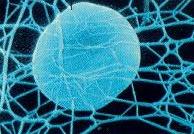 |
Blood: composition and functions

Everybody is familiar with the sight of blood - the red
fluid that oozes out of your body when you've
sustained a cut or an deep injury. The composition
of blood is actually quite complex. Also, as we shall see
in this essay, blood is crucial to our survival.
Blood is the medium in which dissolved gases, nutrients,
hormones and waste products are transported.
Blood along with the heart and the blood vessels (e.g. veins and
arteries) comprises the circulatory system of the body.
The circulatory system helps in maintaining balanced conditions
within the body (i.e. homeostasis). For example oxygen is picked
up by blood as it passes through the lungs- this blood in turn
flows through successively narrower blood vessels: from arteries to
arterioles and finally the capillaries, where
the oxygen rich blood delivers its oxygen to the cells.
Blood is composed of a straw-colored liquid called plasma
which contains suspended cells. The different
specialized cells found in blood are
- red blood cells
- white blood cells
- platelets
Approximately 90% of plasma is water- blood's solvent
with the rest composed of dissolved substances,
primarily proteins (e.g. albumin, globulin, fibronogen).
Plasma typically accounts for 55% by volume of blood
and of the remaining 45% the greatest contribution is
from the red blood cells.
- Red blood cells (also called erythrocytes):
- These are
the familiar discotic shaped cells which make up
99% of the cells in the blood. They are the
principal carriers of the red colored hemoglobin
molecules. Hemoglobin is an iron containing protein and
binds about 97% of all oxygen in the body.
We know that oxygen is not very soluble in water hence
if oxygen were simply dissolved in the fluid of blood
not much could be carried by the bloodstream.
Each hemoglobin molecule binds four oxygen molecules to itself-
consequently hemoglobin permits human blood to carry more than
70 times the amount of oxygen that it could have carried
otherwise.
The unique surface shape of red blood cells is nature's design to
maximize surface area in order to facilitate absorbtion
and release of oxygen. (Given a spherical and a discotic
cell of the same volume which do you think has a greater
surface area and hence more ability to absorb?)
Not all blood is equal: this fact was learnt the hard way
in the mid 1600's when blood from a lamb was transfused
into a human with fatal results. The cell membrane of red blood
cells contains different proteins, which are responsible for
different types of blood. There are primarily two types
of proteins found in the cell membrane of red blood cells-
protein A and B. Different combinations of these proteins and
their antibodies results in four types of blood
- type A : have protein A and antibodies to B protein
- type B : have protein B and antibodies to A protein
- type AB : have both protein A and B but neither of the antibodies
- type O : have neither proteins but have both the antibodies
Type AB is called 'universal acceptor' and type O is called
'universal donor' because of the ability of people with this blood
group to accept blood or donate blood to all other blood groups
respectively.
- White blood cells (also called leukocytes):
- The role of blood
is not confined to the transportation of materila within the
body. The white blood cells are a vital source of defense against
external organisms. White blood cells also serve as 'sanitary
engineers' cleaning up dead cells and tissue debris that would otherwise
accumulate to and lead to problems. There
are five classes of leukocytes: neutrophil, eosinophil, basophil,
monocyte and lymphocytes.
Many infections stimulate the body to release into the bloodstream
large number of protective leukocytes thate are normally held in reserve,
causing the white cell number to rise. The increased number of
white cells is easily detected in a blood test and is an a very
useful first approximation in diagnosis. Some white blood cells
may die in the process of fighting against an infection and their
dead bodies accumulate and contribute to the white substance
that is commonly seen at the sight of infections, usually called
'pus'. Not all infections lead to an increase in the white
blood count- the virus that is responsible for AIDS results in
a reduced white blood count and hence reduced ability to fight
other infections.
- Plasma and platelets in clotting:
- If damage occurs to a blood vessel, circulating platelets
immediately get trapped at the injury site. On accumulating
the platelets 'plug' the leak in the vessel providing a
first step in damage control. This mechanism is supplemented
by 'blood coagulation', or clotting, which is the most important
means of defense against bleeding.
As mentioned plasma contains several dissolved proteins. Fibrinogen
is a rod shaped soluble protein which in the presence of a catalyst
thrombin gets converted to an insoluble protein
fibrin .
Fibrin molecules make a tangled net of fibers by adhering end-to-end and
side-to-side which immobilizes the fluid portion of blood (causing it
to solidify) and also traps the red blood cells.

|
Here we see a red blood cell (which actually looks blue in the picture!)
snared in the fibrin mesh (thin lines) of a blood clot.
|
The combined action of the platelets and 'fibrin web' is sufficient
to prevent a dangerous loss of blood. In cases where the formation
of fibrin and hence formation of a clot is impaired due to some reason
(e.g. a genetic disorder as in hemophilia) a person is at great risk
of bleeding to death.
|



